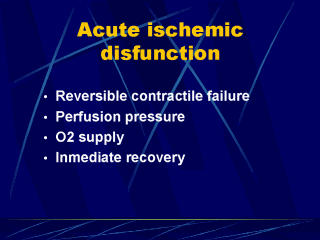| front |1 |2 |3 |4 |5 |6 |7 |8 |9 |10 |11 |12 |13 |14 |15 |16 |17 |18 |19 |20 |21 |22 |23 |24 |25 |26 |27 |review |
 |
Ischemia causes
a pr4edictable derangement of myocardial function and myocyte metabolism. Contractile dysfunction occurs within sedconds fo coronary arytery occlusion. Depletion of the myosytes high-energy phosphates, accumulation of lactic asid,and intracellular acidosis soon follow in the absence of oxygen, as anaerobic glycolysis replaces the Krebs cycle as the major source of adenosine triphosphate, ATP. When myocyte ATP levels decline to a critical level, inability to maintain electrolyte gradients that require active transport cause cellular edema, intracellular Ca2+ overload, loss of mebrane integrity, and ultimately, in the setting of terminal "no reflow" ischemia, cell necrosis. |